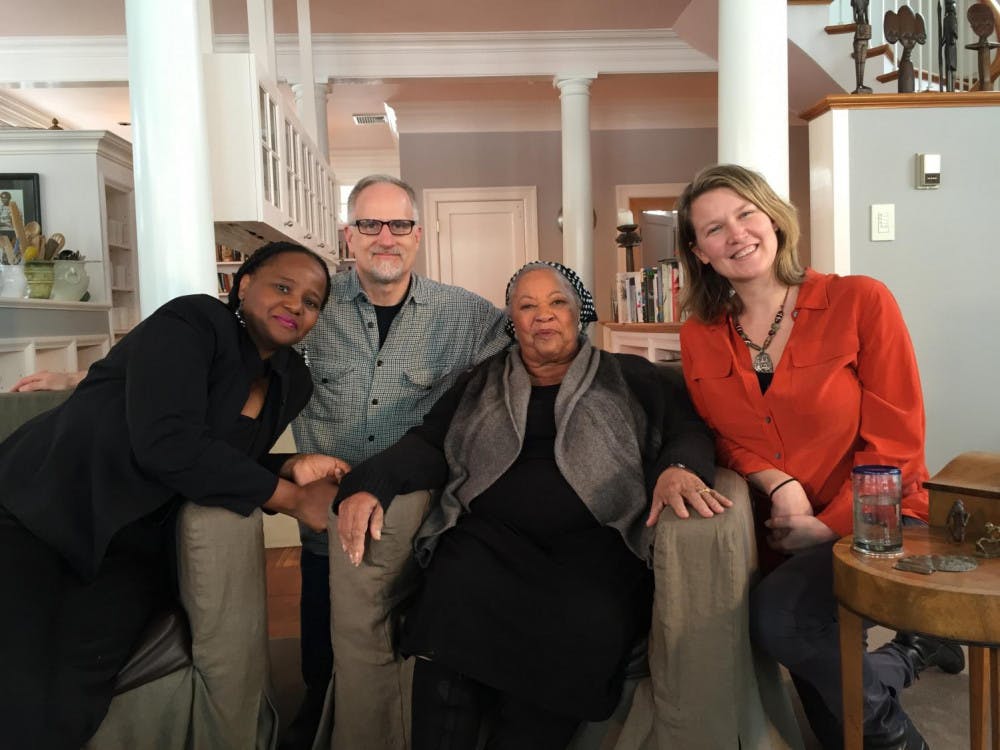Filmmakers Rian Brown and Geoff Pingree recalled a screening in Miami, after which a man in his seventies came up to tell them that he wished he had seen the film when he was 22 years old, and that it would have changed his life. “He went on and on,” Pingree said. “And that was really gratifying when someone says that.”
The potentially life-changing film is “The Foreigner’s Home,” directed by Brown and Pingree, a documentary that delves deep into Toni Morrison’s ideas and works through the eponymous 2006 exhibition she guest-curated at the Louvre. The two filmmakers’ gratification from making the film and bringing it to different places was clearly visible and transmittable during its screening last Thursday at the annual Clifford Symposium.
“The film is a call to action — to all of us, but with a special nod to the role of the artist, as a defender of our civilization and of our humanity,” Brown said.

The poster of the documentary features director Rian Brown’s animation design.
In that sense, the film shares not only the title but also the aspirations and critical reflections of the exhibition in Paris. According to Brown, in 2006, Morrison brought in writers, artists, musicians and filmmakers from around the world “to speak to and interact with the dead artists housed in the Louvre,” centering on the conceptual construction of the foreigner and otherness.
Morrison’s son, Ford Morrison, filmed the exhibition. Years later, through mutual friend and colleague Jonathan Demme, Brown and Pingree, both faculty members at Oberlin College, were asked to look at Ford Morrison’s footage. It was firmly agreed from the start that Toni Morrison would not be in the film and that the film should be about her visions instead of her life.
The two spent three years navigating the extensive materials and bringing them to life. Pingree said that while Morrison is “riveting” in the way she talks and remains so in film, the short version consisting of only the exhibit’s footage was not satisfactory for him and Brown. Realizing that Morrison’s reappearance in the film would be indispensable, they wrote a letter to her, explaining the importance of having her on camera almost 10 years after her exhibit in Paris.
“It was at the time when Syria had exploded into war, and suddenly this massive movement of displaced people moved to the front,” Pingree said. “We saw this happening all around and thought, well, what the film really needs is for her to address now these questions 10 years later.”
Morrison agreed, and that led to the heartfelt conversations between Morrison and writer Edwidge Danticat that make up a central element of the film. We see Danticat greeting Morrison at her home and interviewing her about the 2006 exhibit, which they were both part of, as well as the pressing issues today. Throughout their dialogue, the film introduces viewers to pieces of the exhibition, including slam poets’ and rappers’ performances in front of large paintings and multiple screens installed in the gallery showing a modern dance piece.
One painting that features in the film many times is “The Raft of the Medusa” (1819), an oil painting by French painter Théodore Géricault. Its large scale highlights the strong emotional effect of the moment depicted — people struggling to survive after a shipwreck — and the film shows the details of the devastated people by occasionally zooming in and out on it.
Juxtaposed with the painting is Morrison’s voice. Be it her past interview with a French radio station or her Nobel Prize in Literature acceptance speech, her indeed captivating way of talking brings together different archival footages, ranging from groundbreaking artists’ performances from different times to more recent scenes of racial violence and inequality.
“The idea was to create the sense that Toni Morrison’s voice speaking and the import of her message is transcending time, space and media, so we are kind of soaring through the history and the world now,” Pingree said.
Brown’s animation, which both the filmmakers and audiences agreed is beautiful and moving, is another crucial element in combining Morrison’s ideas with imagery. From the very beginning, a boat packed with people in the distance moves closer to the audience against the deep navy backdrop of night sky and sea. The boat as a motif resonates with the “Medusa” painting as well as the migration crisis that has led millions of people to cross an ocean in search of a new home.
Throughout the film, the animation sequence reappears, at times in a montage with actual footages of migrants arriving by boat and getting rescued.
“That is the embodiment of the foreigner [and] ‘what is the foreigner,’” Brown said. “The foreigner is not home. The foreigner is in a vulnerable place.”
The film premiered this January at the International Film Festival in Rotterdam, where the two directors began the process of planning for its distribution. Brown described some of the “hard conversations” they had to have with distributors, as not all of them were able to help fulfill the mission of the film, which is to be educational. Eventually, they signed The Video Project, which will first distribute the film to libraries, community centers and universities.

One of the rappers performing slam poetry at the Louvre.
“Our primary purpose [that] was very clear and unequivocal is for it to go to schools, not just colleges like Oberlin or Middlebury, which is a pretty privileged set of people,” Pingree said. “Anyone who asks for it, we will take it to them and let them use it. … This is just the obviously correct thing to do with this film, for it to be something that people talk about.”




